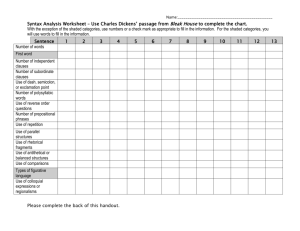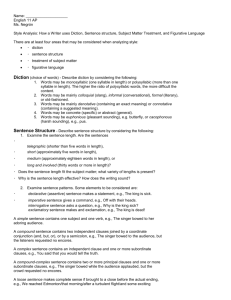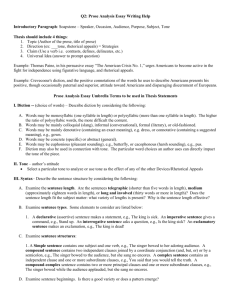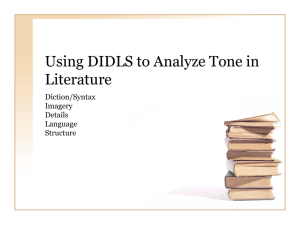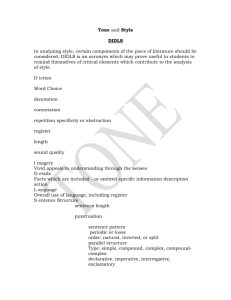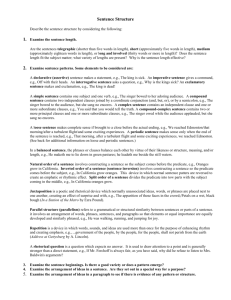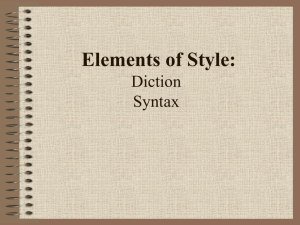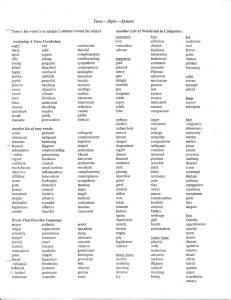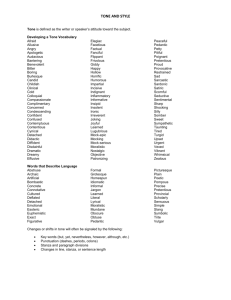Passage Analysis--Question 2 on AP Exam
advertisement
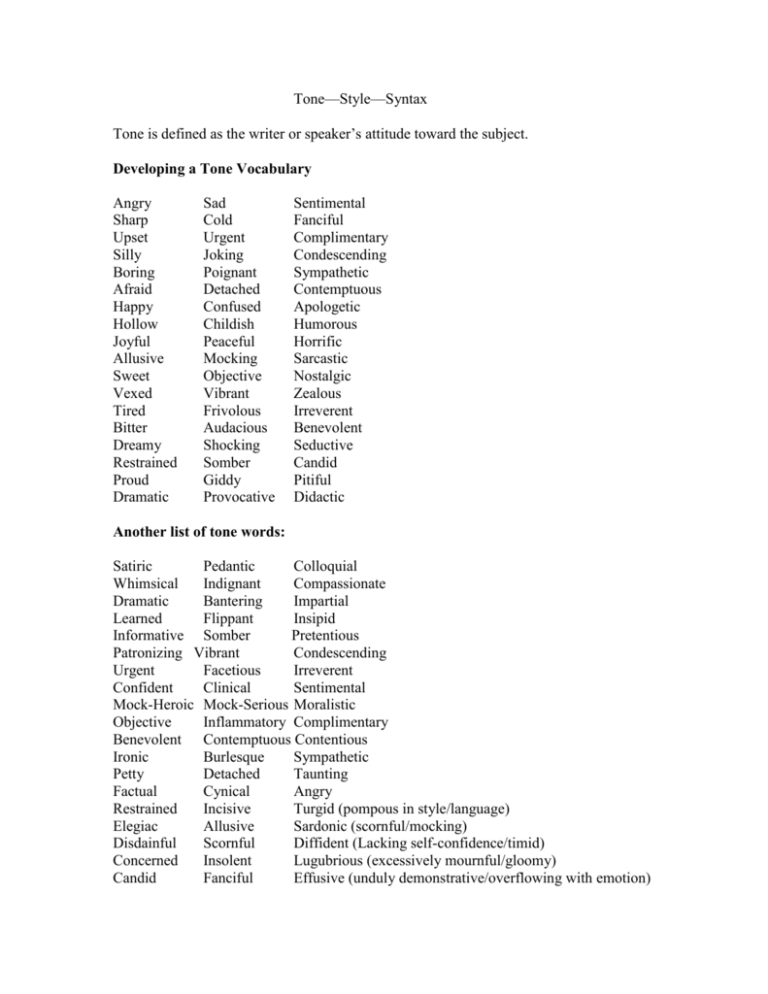
Tone—Style—Syntax Tone is defined as the writer or speaker’s attitude toward the subject. Developing a Tone Vocabulary Angry Sharp Upset Silly Boring Afraid Happy Hollow Joyful Allusive Sweet Vexed Tired Bitter Dreamy Restrained Proud Dramatic Sad Cold Urgent Joking Poignant Detached Confused Childish Peaceful Mocking Objective Vibrant Frivolous Audacious Shocking Somber Giddy Provocative Sentimental Fanciful Complimentary Condescending Sympathetic Contemptuous Apologetic Humorous Horrific Sarcastic Nostalgic Zealous Irreverent Benevolent Seductive Candid Pitiful Didactic Another list of tone words: Satiric Pedantic Colloquial Whimsical Indignant Compassionate Dramatic Bantering Impartial Learned Flippant Insipid Informative Somber Pretentious Patronizing Vibrant Condescending Urgent Facetious Irreverent Confident Clinical Sentimental Mock-Heroic Mock-Serious Moralistic Objective Inflammatory Complimentary Benevolent Contemptuous Contentious Ironic Burlesque Sympathetic Petty Detached Taunting Factual Cynical Angry Restrained Incisive Turgid (pompous in style/language) Elegiac Allusive Sardonic (scornful/mocking) Disdainful Scornful Diffident (Lacking self-confidence/timid) Concerned Insolent Lugubrious (excessively mournful/gloomy) Candid Fanciful Effusive (unduly demonstrative/overflowing with emotion) Words That Describe Language: Jargon Vulgar Scholarly Sensuous Precise Learned Connotative Plain Literal Colloquial Artificial Detached Emotional Pedantic Euphemistic Pretentious Idiomatic Exact Cultured Symbolic Simple Figurative Bombastic Obscure Grotesque Concrete Poetic Moralistic Slang Insipid (lacking stimulating or interesting qualities) Concrete Esoteric (belonging to a select few or private sect) Picturesque Homespun Provincial Trite Abstruse (difficult to comprehend) Precise Exact Often a change or shift in tone will be signaled by the following: * key words (i.e. but, yet, nevertheless, however, although) * punctuation (dashes, periods, colons) * stanza and paragraph divisions * changes in line and stanza or sentence length There are at least 4 areas that may be considered when analyzing style: diction, sentence structure, treatment of subject matter, and figurative language. I. Diction (choice of words)—Describe diction by considering the following: A. Words may be monosyllabic (one syllable in length) or polysyllabic (more than one syllable in length). The higher the ratio or polysyllabic words, the more difficult the content. B. Words may be mainly colloquial (slang), informal (literary), or oldfashioned. C. Words may be mainly denotative (containing an exact meaning), e.g. dress, Or connotative (containing a suggested meaning), e.g., gown. D. Words may be concrete (specific) or abstract (general). E. Words may be euphonious (pleasant sounding), e.g. butterfly, or cacophonous (harsh sounding), e.g. pus. II. Sentence Structure—Describe the sentence structure by considering the following: A. Examine the sentence length. Are the sentences telegraphic (shorter than five words in length), medium (approximately 18 words in length), or long and involved (30 words or more in length)? Does the sentence length fit the subject matter; what variety of lengths is present? Why is the sentence length effective? B. Examine sentence patterns. Some elements to consider are listed below: 1. A declarative (assertive) sentence makes a statement, e.g., The king is sick. An imperative sentence give a command, e.g., Stand up. An interrogative sentence asks a question, e.g., Is the king sick? An exclamatory sentence makes an exclamation, e.g., The king is dead! 2. A simple sentence contains one subject and one verb, e.g., The singer bowed to her adoring audience. A compound sentence contains 2 independent clauses joined by a coordinate conjunction (and, but, or) or by a semicolon, e.g., The singer bowed to the audience, but she sang no encores. A complex sentence contains an independent clause and one or more subordinate clauses, e.g., You said that you would tell the truth. A compound-complex sentence contains two or more principal clauses and one or more subordinate clauses, e.g. The singer bowed while the audience applauded, but she sang no encores. 3. A loose sentence makes complete sense if brought to a close before the actual ending, e.g., We reached Edmonton/that morning/after a turbulent flight/and som exciting experiences. A periodic sentence makes sense only when the end of the sentence is reached, e.g., That morning, after a turbulent flight and some exciting experiences, we reached Edmonton. 4. In a balanced sentence, the phrases or clauses balance each other by virtue of their likeness or structure, meaning, and/or length, e.g., He maketh me to lie down in green pastures; he leadeth me beside the still waters. 5. Natural order of a sentence involves constructing a sentence so the subject comes before the predicate,, e.g.,, Oranges grow in California. Inverted order of a sentence (sentence inversion) involves consructing a sentence so the predicate comes before the subject, e.g., In California grow orange. This is a device in which normal sentence patterns are reversed to create an emphatic or rhythmic effect. Split order of a sentence divdies the predicate into two parts with the subject coming in the middle, e.g., In California oranges grow. 6. Juxtaposition is a poetic and rhetorical device in which normally unassociated ideas, words, or phrases are placed next to one another, creating an effect of surprise and wit, e.g., The apparition of these faces in the crowd;/Petals on a wet, black bough.” (“In a Station of the Metro” by Pound). 7. Parallel structure (parallelism) refers to a grammatical or structural similarity between sentences or parts of a a sentence. It involves an arrangement of words, phrases, sentences, and paragraphs so that elements of equal importance are equally developed and similarly phrased, e.g., He was walking, running, and jumping for joy. 8. Repetition is a device in which words, sounds, and ideas are used more than once for the purpose of enhancing rhythm and creating emphasis, e.g., “…government of the people, by t he people, for the people, shall not perish from the earth.” 9. A rhetorical question is a question which expects no answer. It is used to draw attention to a point and is generally stronger than a direct statement, eg.,., If Mr. Smith is always fair, as you have said, why did he refuse to listen to Mrs. Baldwin’s arguments? C. Examine sentence beginnings. Is there a good variety or does a pattern emerge? D. Examine the arrangement of ideas in a sentence. Are they set out in a special way for a purpose? E. Examine the arrangement of ideas in a paragraph to see if there is evidence of any pattern or structure. III. Treatment of Subject Matter Describe the author’s treatment of the subject matter by considering the following. Has the author been: 1. Subjective? Are his conclusions based upoin facts; are they impersonal or scientific? 2. Objective? Are his conclusions based upon facts; are they impersonal or scientific? 3. Supportive of his main idea? If so, how did he support his claims? Did he: a. State his opinions, b. report his experience, c. report observations, d. refer to readings, e. refer to statements made by experts, f., use statistical data? IV. Figurative Language a. Simile is a comparison of two different things or ideas through the use of the words like or as. It is definitely a stated comparison, where the poet says one thing is like another, e.g., The warrior fought like a lion. b. Metaphor is a comparison without the use of like or as. The poet states that one thing is another. It is usually a comparison between something that is real or concrete and something that is abstract, e.g…, Life is but a dream. c. Personification is a kind of metaphor which gives inanimate objects or abstract ideas human characteristics, e.g., The wind cried in the dark. d. Hyperbole is a deliberate, extravagant, and often outrageous exaggeration. It may be used either for serious or comic effect, eg. The shot that was heard ‘round the world. e. Understatement (Meiosis) is the opposite of hyperbole. It is a kind of irony which deliberately represents something as much less than it really is, e.g., I could probably manage to survive on a salary of two million dollars per year. f. Paradox is a statement which contradicts itself. It may seem almost absurd. Although is may seem to be at odds with ordinary experience, it usually turns out to have a coherent. Meaning, and reveals a truth which is normally hidden, e.g., The more you know, the more you know you don’t know. (Socrates)
